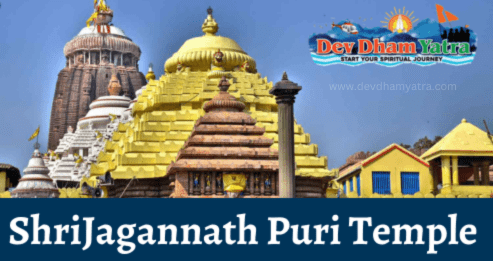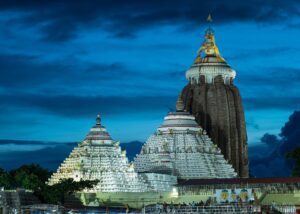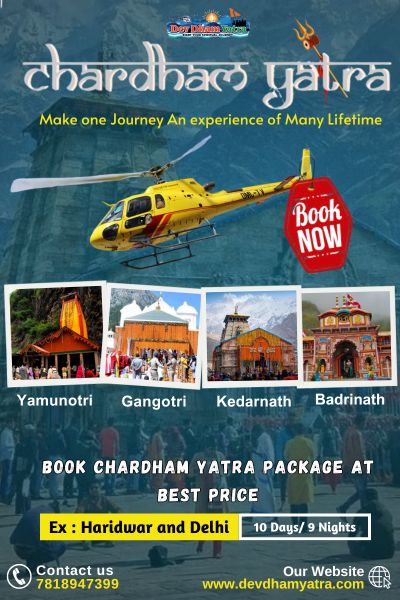Jagannath Temple, Odisha: A Spiritual Oasis in the Heart of Puri
The Jagannath Temple, located in the historic city of Puri, Odisha, India, is a renowned Hindu temple that attracts millions of devotees and tourists each year. This sacred place of worship is dedicated to Lord Jagannath, an incarnation of Lord Vishnu, and holds immense religious and cultural significance. Let’s delve into the captivating history, architectural marvels, and spiritual aura of the Jagannath Temple.
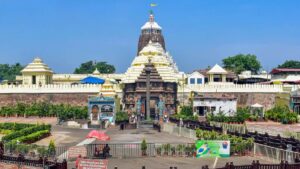
Rich History: The Jagannath Temple dates back to ancient times and has a rich history that adds to its allure. It was built in the 12th century during the reign of King Anantavarman Chodaganga Deva of the Eastern Ganga dynasty. Over the centuries, the temple has undergone several renovations and additions, showcasing the blend of architectural styles, including Kalinga and Dravidian influences.
Architectural Marvels: The temple’s architecture is a magnificent sight to behold. The main temple structure stands tall with its towering spire, called the ‘Shikhara,’ reaching a height of over 200 feet. The intricate carvings and sculptures adorning the temple walls depict mythological stories and legends. The entrance of the temple is guarded by two mighty lion sculptures, known as ‘Simha Dwara,’ and the main sanctum is known as the ‘Garbhagriha.’
Rituals and Festivals: The Jagannath Temple is famous for its elaborate rituals and grand festivals. The daily rituals, known as ‘Niti,’ include offerings of food to the deities, known as ‘Mahaprasad,’ which is considered highly sacred and believed to be blessed by the Lord Himself. The annual Rath Yatra, or Chariot Festival, attracts a massive gathering as Lord Jagannath, along with His siblings Lord Balabhadra and Devi Subhadra, are taken out in a grand procession on elaborately decorated chariots, pulled by thousands of devotees.
Spiritual Significance: The Jagannath Temple holds great spiritual significance for devotees. It is believed that a visit to the temple and seeking the darshan (sight) of Lord Jagannath can grant liberation from the cycle of birth and death. The temple complex also houses smaller shrines dedicated to various other deities, adding to the spiritual ambiance.
Cultural Heritage: Beyond its religious importance, the Jagannath Temple is a testament to India’s rich cultural heritage. The temple’s architecture, sculptures, and rituals reflect the artistic and architectural brilliance of ancient times. The temple also serves as a hub for Odissi classical dance performances and showcases the region’s traditional music, dance, and arts during festivals and cultural events.
Information about Jagannath Temple Puri
The Jagannath Temple, situated in Puri, Odisha, India, is a highly revered Hindu temple dedicated to Lord Jagannath, an incarnation of Lord Vishnu. This sacred temple holds immense religious significance and is one of the Char Dham pilgrimage sites for Hindus. It is believed that a visit to the Jagannath Temple brings blessings and spiritual enlightenment to devotees.
Location and Timing:
The Jagannath Temple is located in the heart of Puri, a coastal town in Odisha. The temple opens early in the morning and remains open until late evening.
Aarti:
Aarti, the ceremonial worship involving light and prayers, holds a significant place in the daily rituals of the Jagannath Temple. Devotees gather in the temple premises to witness the mesmerizing Aarti ceremony, where priests offer prayers, chant mantras, and wave-lit oil lamps in front of the deities. The divine atmosphere during the Aarti fills the hearts of devotees with devotion and tranquility.
Entry Fee:
The Jagannath Temple does not charge any entry fee for devotees. The temple is open to all, irrespective of caste, creed, or nationality. However, it is advisable to carry some small change for offerings or donations as a gesture of reverence.
Time to See:
The time required to explore the Jagannath Temple premises may vary depending on individual preferences and the crowd present. Devotees can spend anywhere from a few hours to half a day within the temple complex, immersing themselves in the divine aura, participating in rituals, and seeking blessings from the deities. It is recommended to allocate sufficient time to experience the temple’s grandeur fully.
How to reach :
- By Air: The nearest airport to Puri is the Biju Patnaik International Airport in Bhubaneswar, which is approximately 60 kilometers away. From the airport, you can hire a taxi or take a bus to reach Puri.
- By Train: Puri has its railway station, which is well-connected to major cities in India. There are regular train services from cities like Kolkata, Chennai, Delhi, Mumbai, and many more. Once you reach the Puri railway station, the temple is just a short distance away.
- By Road: Puri is well-connected by road to various cities in Odisha and neighboring states. You can take a bus or hire a taxi to reach Puri. The National Highway 316 connects Puri to other major cities like Bhubaneswar and Cuttack.
- By Bus: There are regular bus services to Puri from nearby cities and towns. The Odisha State Road Transport Corporation (OSRTC) operates buses to Puri from different parts of the state. Private bus operators also run services to Puri from neighboring states.
It’s important to note that during major festivals like the Rath Yatra, the transportation arrangements may be different and require additional planning due to the high influx of pilgrims. It’s advisable to check the local transport authorities or tourism offices for specific information during such times.
Explore
Here are some things to explore within the temple complex:
1. Main Temple: The main temple is dedicated to Lord Jagannath, an incarnation of Lord Vishnu. It is an architectural marvel with its towering spires and intricate carvings. The temple has strict entry restrictions for non-Hindus, but you can admire its beauty from the outside.
- Entry: The main temples allow only Hindus
- Timings: Opens Early Morning and remains open throughout the day. However, it is closed for a few hours during the afternoon
- Aarti: Arti is performed multiple times including Morning evening and night called Mangal Arti, Sandhya Arti, and Shayna Arti respectively.
- Time to See: It took nearly 30 minutes to visit the temple and offer prayer.
2. Rath Yatra: The annual Rath Yatra or Chariot Festival is a major attraction of the Jagannath Temple. During this festival, the deities are taken out in grand processions on elaborately decorated chariots. It is a vibrant and festive event that draws thousands of devotees and tourists.
- Entry: The Rath Yatra is open to all devotees and tourists, regardless of their religion.
- Timings: The Rath Yatra takes place annually, usually during June or July. The exact dates vary each year.
- Aarti: During the Rath Yatra, special aartis are performed for the deities while they are on the chariots.
- Time to See: The Rath Yatra procession lasts for several hours, providing ample time to witness the grand spectacle.
3. Temple Kitchen: The Jagannath Temple has one of the largest kitchens in the world, known as the Anand Bazaar or Mahaprasad. Here, you can witness the preparation of the sacred food offered to the deities. The temple serves free meals to thousands of devotees every day.
- Entry: The Anand Bazaar or Mahaprasad is open to all devotees and visitors.
- Timings: The temple kitchen operates throughout the day, preparing meals for devotees.
- Aarti: No specific aarti is performed in the temple kitchen.
- Time to See: You can visit the temple kitchen at any time during the day to observe the preparation of the sacred food.
4. Garden and Rosary: The temple complex also includes a beautiful garden known as the Koili Baikuntha. It is a serene spot where you can relax amidst nature. Adjacent to the garden is the Rosary, which has sacred Tulsi (holy basil) plants.
- Entry: The garden and rosary are open to all visitors.
- Timings: They are accessible during the temple’s opening hours.
- Aarti: No specific aarti is performed in the garden and rosary.
- Time to See: You can spend around 30 minutes to an hour exploring the garden and rosary.
5. Museum: The temple houses a museum called the Jagannath Temple Museum. It showcases a rich collection of sculptures, artifacts, and paintings related to the temple’s history and culture. You can explore the exhibits to learn more about the temple’s heritage.
- Entry: The Jagannath Temple Museum is open to all visitors.
- Timings: The museum operates during the temple’s opening hours.
- Aarti: No specific aarti is performed in the museum.
- Time to See: You can allocate around 1 to 2 hours to explore the museum and its exhibits.
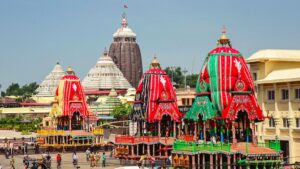
History
The history of the Jagannath Temple, also known as the Shree Jagannath Puri Temple, is deeply rooted in Hindu mythology and dates back to ancient times. Here’s a brief overview of its history:
- Ancient Origins: The exact origins of the temple are shrouded in legends and folklore. According to Hindu mythology, Lord Jagannath, an incarnation of Lord Vishnu, has been worshipped in Puri since time immemorial. It is believed that the original temple was built by King Indradyumna, a legendary ruler mentioned in the Puranas (ancient Hindu texts).
- King Anantavarman Chodaganga Deva: The current structure of the Jagannath Temple was commissioned by King Anantavarman Chodaganga Deva, a ruler of the Eastern Ganga Dynasty, in the 12th century. He is credited with the construction of the main temple and the establishment of the rituals and practices followed in the temple.
- Marathas and British Rule: The Jagannath Temple faced several invasions and attacks over the centuries. It was plundered by Muslim rulers in the 16th century and later suffered damages during the Maratha invasions in the 18th century. During British rule, the temple faced restrictions and control from the colonial authorities.
- Reconstruction and Preservation: Despite facing numerous challenges, the temple has been rebuilt and restored several times throughout history. Devotees and rulers made significant efforts to preserve the sanctity of the temple and its rituals. The present structure of the temple is the result of various renovations and reconstructions carried out over the centuries.
- Cultural Significance: The Jagannath Temple holds immense cultural significance, not just for the people of Odisha but for Hindus worldwide. It is one of the Char Dham pilgrimage sites in Hinduism and is considered one of the holiest temples in India. The annual Rath Yatra, during which the deities are taken out in grand processions, attracts millions of devotees from all corners of the country.
The Jagannath Temple stands as a symbol of devotion, spirituality, and architectural brilliance. Its rich history intertwines with the beliefs and traditions of millions of devotees who consider it a sacred abode of Lord Jagannath.

Architect
The exact identity of the architect or architects who designed the Jagannath Temple in Puri is not known. The temple’s construction dates back to the 12th century during the reign of King Anantavarman Chodaganga Deva of the Eastern Ganga Dynasty. The names of the architects involved in the temple’s design and construction have not been recorded in historical records or inscriptions.
The temple’s architectural style reflects the Kalinga architecture, which is characterized by its unique features such as the curvilinear tower (shikhara), intricate stone carvings, and sculptural embellishments. The temple’s main structure consists of four distinct components: the Vimana (sanctum sanctorum), Jagamohana (porch), Nata Mandir (festival hall), and Bhoga Mandap (offering hall).
Over the centuries, the temple has undergone renovations and repairs due to natural calamities, invasions, and age-related deterioration. Skilled artisans and craftsmen have contributed to the preservation and restoration of the temple, ensuring its architectural integrity and grandeur.
While the specific names of the architects remain unknown, the Jagannath Temple in Puri stands as a testament to the architectural prowess and creativity of the artisans of ancient India. The temple’s awe-inspiring design and intricate artwork continue to captivate visitors and devotees from around the world.
Hotels near Jagannath Temple
- Mayfair Heritage: Located near the beach, Mayfair Heritage offers luxurious accommodations with spacious rooms, modern amenities, and a serene ambiance. It is situated within walking distance of the Jagannath Temple.
- Hotel Nilachal Ashok: This government-run hotel is located near the sea beach and provides comfortable rooms with basic amenities. It is a budget-friendly option and is situated close to the Jagannath Temple.
- Hotel Holiday Resort: Situated near the beach, Hotel Holiday Resort offers a range of room options, including cottages and suites. The hotel provides modern amenities, multiple dining options, and recreational facilities. It is within proximity to the Jagannath Temple.
- Hotel Surya Beach Inn: This hotel is located near the beach and offers clean and comfortable rooms at affordable prices. It provides basic amenities and is conveniently located close to the Jagannath Temple.
- Hotel Sonar Bangla: Situated near the sea beach, Hotel Sonar Bangla offers comfortable rooms with beautiful views. The hotel provides modern amenities, and an in-house restaurant, and is within reach of the Jagannath Temple.
Places to visit near Jagannath Temple
- Konark Sun Temple: Located approximately 35 kilometers from Puri, the Konark Sun Temple is a UNESCO World Heritage Site and a marvel of ancient architecture. The temple is dedicated to the Sun God and is renowned for its intricate stone carvings and impressive chariot-shaped structure.
- Chilika Lake: Situated around 50 kilometers from Puri, Chilika Lake is the largest coastal lagoon in India and a haven for birdwatchers. You can take a boat ride on the lake, spot migratory birds, and explore the scenic beauty of the surrounding mangroves and islands.
- Puri Beach: Just a short distance from the Jagannath Temple, Puri Beach is a popular destination for both pilgrims and tourists. You can relax on the sandy shores, take a dip in the sea, indulge in beachside activities, and savor delicious seafood from the local vendors.
- Raghurajpur Crafts Village: Situated around 15 kilometers from Puri, Raghurajpur is a traditional crafts village known for its exquisite Pattachitra paintings, stone and wood carvings, and palm leaf etchings. You can visit the artists’ homes and witness their intricate craftsmanship.
- Satapada: Located approximately 50 kilometers from Puri, Satapada is a picturesque spot where the Chilika Lake meets the Bay of Bengal. It is famous for its dolphin sightings, boating opportunities, and the stunning natural beauty of the surrounding wetlands.
- Gundicha Temple: Situated within walking distance from the Jagannath Temple, Gundicha Temple holds immense religious significance. It is believed to be the place where Lord Jagannath stays during the annual Rath Yatra. The temple is worth a visit for its serene atmosphere and architectural splendor.
- Pipili: Located about 20 kilometers from Puri, Pipili is renowned for its vibrant appliqué work. The town is known for its colorful traditional textiles, wall hangings, and handicrafts. You can visit the local workshops and shops to witness the intricate craftsmanship.
These nearby places offer diverse experiences, from architectural wonders to natural beauty and cultural heritage. They provide an opportunity to delve deeper into the rich cultural and historical tapestry of the region surrounding the Jagannath Temple.
FAQs
Q1: Can non-Indian/non-Hindu go inside the temple?
A1: No, non-Indians/non-Hindus are not allowed to enter the main sanctum of the Jagannath Temple in Puri. The temple has strict entry restrictions and is open only to Hindus.
Q2: Is there an entry fee to visit Jagannath Temple?
A2: No, there is no entry fee to visit the Jagannath Temple. However, there may be charges for special darshan or seva (worship) services offered within the temple complex.
Q3: Can we take photographs inside the temple complex?
A3: No, photography is strictly prohibited inside the temple complex. Visitors are not allowed to take photographs of the main deity or any other sacred areas within the temple premises.
Q4: Can we bring food inside the temple complex?
A4: No, outside food is not allowed inside the temple complex. The temple has a kitchen where sacred food (Mahaprasad) is prepared and offered to devotees. You can partake in the Mahaprasad from the temple kitchen.
Q5: Are there any specific guidelines for visiting with children?
A5: While there are no specific guidelines for visiting with children, it is advisable to ensure their safety and well-being during the visit. The temple premises can be crowded, so keeping an eye on children and following any instructions from the temple authorities is recommended.
Q6: Is JaganathTemple accessible for people with disabilities?
A6: Yes, the Jagannath Temple is accessible for people with disabilities, although there may be certain limitations due to the ancient structure. It is advisable to contact the temple authorities for specific information and assistance regarding accessibility.
Q7: What are the visiting hours of Jagannath Temple?
A7: The Jagannath Temple opens early in the morning and remains open throughout the day. However, it is closed for a few hours during the afternoon. The exact visiting hours may vary, so it is advisable to check the temple’s official website or contact the temple authorities for the most up-to-date information on visiting hours.

